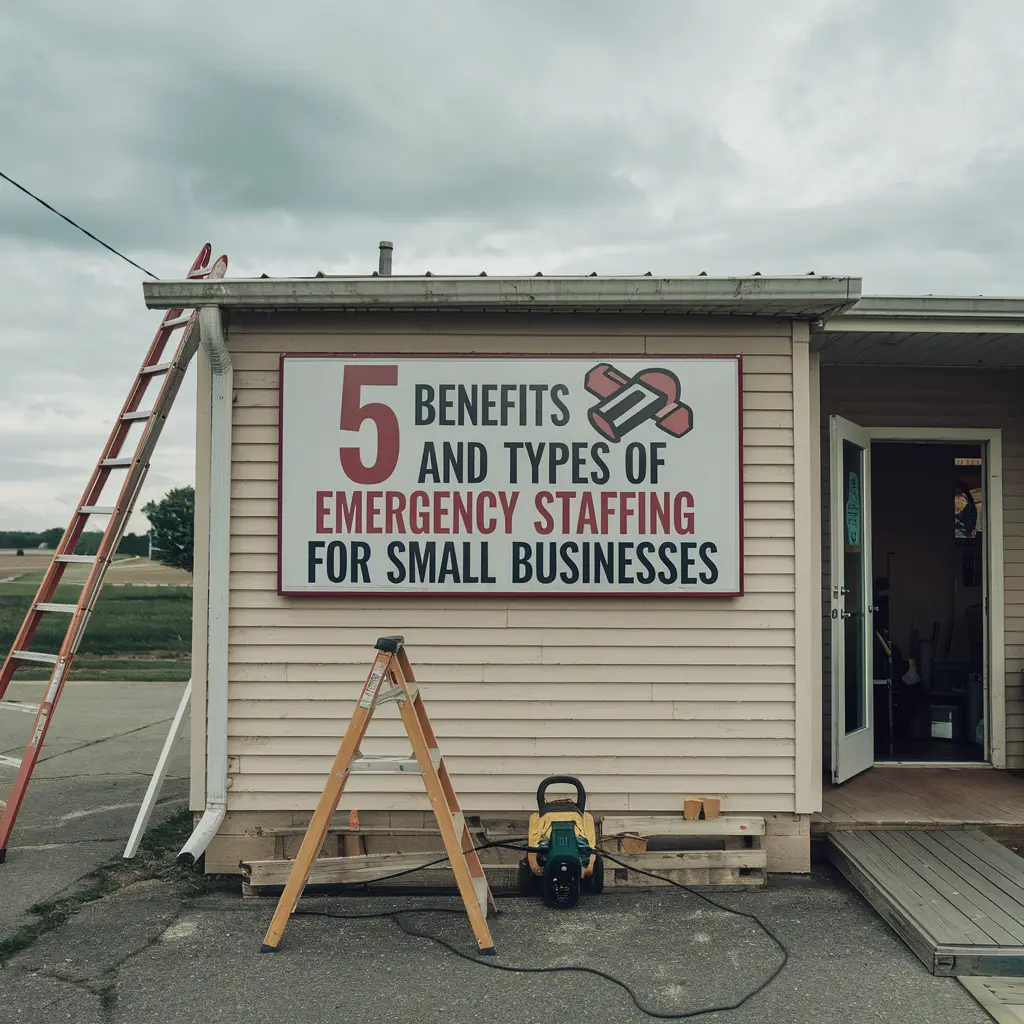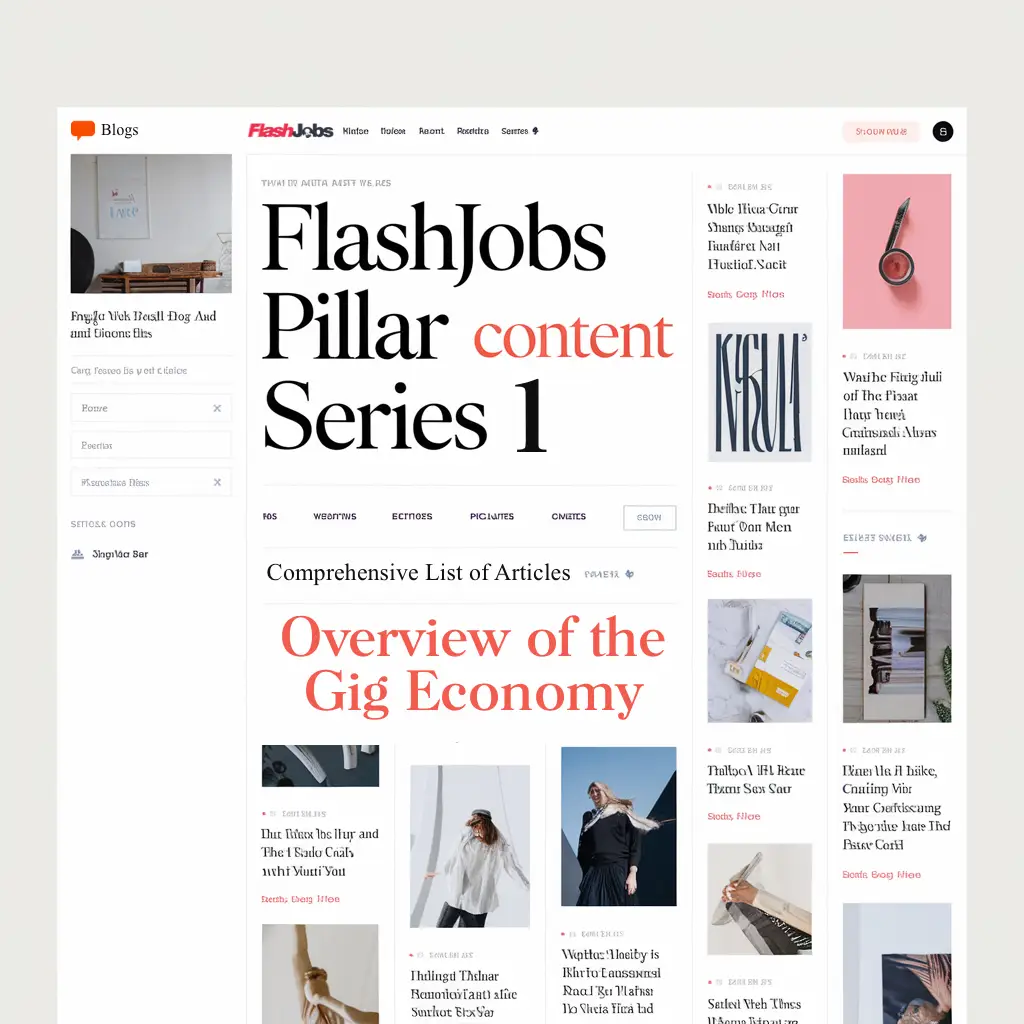Table of Contents
Did you know that by 2025, an estimated 540 million people could seek work through online talent platforms? This prediction from McKinsey shows the gig economy’s fast growth and big potential. We’ll examine the history of the gig economy and see how it’s changing the game for workers and small businesses.
The gig economy has existed for a long time, even before the Industrial Revolution. It has grown and changed with the digital age. Now, platforms like FlashJobs lead the way, offering flexible work options and connecting businesses with talent in new ways.
Ride-sharing and freelance writing have changed how we view work. It’s not just for extra cash anymore. For many, it’s their main job and a way to start their own business. Let’s see how we got here and what it means for the future of work.
Key Takeaways
-
- The gig economy is expected to involve 540 million job seekers by 2025
-
- Gig work has evolved from pre-industrial times to the digital age
-
- Platforms like FlashJobs are reshaping how workers and businesses connect
-
- 36% of the American workforce engaged in freelance work in 2021
-
- The gig economy contributed $1.3 trillion to the U.S. economy in annual earnings
-
- 49% of gig workers prioritize flexible hours for better work-life balance
Introduction
The gig economy has changed how we work, bringing in a new era of flexible jobs. This workforce transformation has also changed traditional jobs, offering opportunities for independent work and on-demand jobs.
Defining the Gig Economy
The gig economy is all about short-term contracts and freelance work. By 2023, 64 million Americans, or 38% of the U.S. workforce, were part of this flexible work setup. These freelancers added a huge $1.27 trillion to the economy.
FlashJobs: Innovating the Gig Landscape
FlashJobs is a standout in this changing job market. It offers a special platform for various sectors and worker needs. It meets the growing need for flexible work, as 33% of regular employees want to switch to gig jobs for more flexibility.
Understanding the Gig Economy’s Impact
It’s important to understand the gig economy’s history and effects. It brings benefits like flexibility and more productivity. But it also has challenges. For example, in 2022, gig workers felt worse about their mental health and life satisfaction than full-time workers.
| Aspect | Traditional Employment | Gig Economy |
|---|---|---|
| Work Schedule | Fixed hours | Flexible hours |
| Income Stability | Steady paycheck | Variable income |
| Benefits | Often included | Usually not provided |
| Job Security | Generally higher | Less secure |
| Work-Life Balance | Can be challenging | Potentially better |
As the gig economy grows, platforms like FlashJobs are key in shaping its future. They help balance the needs of workers and businesses in this ever-changing job world.
Origins and Early Development
The gig economy has its roots in pre-industrial times. Workers took on odd jobs to make extra money. This laid the foundation for today’s flexible work world—craftsmen, artists, and seasonal workers Artisans on in this early gig economy.
Industrial Revolution’s Impact
The Industrial Revolution changed how people worked. Factory jobs became the standard, moving away from the gig economy of before. This led to formal employment, which shaped the labour market we know today.
Emergence of Early Freelancers and Gig Economy
In the early 1900s, writers, artists, and musicians paved the way for what would eventually become the modern freelance gig economy. Interestingly, it was jazz musicians who played a pivotal role in shaping the terminology and concept of freelance work as we know it today.
The term “gig” has its roots in jazz culture. Jazz musicians began using “gig” to refer to their one-night engagements or performances in the 1920sic community, and it became a common way to describe short-term, project-based work. The word “gig” is believed to be a shortened form of “engagement,” reflecting the temporary nature of these musical jobs.
As jazz grew in popularity during the 1920s and 1930s, musicians often moved from one short-term “gig” to another, playing at different venues or with various bands. This lifestyle embodied the essence of freelancing – working independently for multiple clients rather than being permanently employed by a single organization. The flexibility and autonomy of this work arrangement appealed to many artists despite the challenges of unstable income and lack of benefits.
The use of “gig” to describe freelance work gradually expanded beyond the music industry. By the 1950s, the term had begun to be applied more broadly to any temporary job or assignment. This linguistic evolution mirrored the growing freelance and contract work trend across various creative and professional fields.
The early freelancers of the 1900s, particularly these pioneering jazz musicians, faced many challenges that gig workers encounter today. They had to navigate irregular income streams, lack of job security, and absence of employer-provided benefits. However, they also enjoyed the freedom to choose their projects and the ability to work with a diverse range of clients and collaborators.
This early form of gigging set the stage for the diverse and expansive gig economy we see today, where freelancers and independent contractors work across numerous industries, from creative fields to technology and beyond. The legacy of these early 20th-century freelancers, especially the jazz musicians who popularized the term “gig,” continues to influence how we perceive and discuss flexible, project-based work in the modern era.
“Freelance work in the early 1900s was a precursor to our modern gig economy, showcasing the enduring appeal of flexible employment.”
The gig economy grew beyond creative fields over time. By 2022, nearly 65 million Americans were part of it. Experts predict that by 2028, over half of the U.S. labour force will be gig workers. This shows how important this work model has become.
| Year | Gig Economy Workers in the U.S. |
|---|---|
| 2022 | 65 million |
| 2028 (Projected) | 90 million |
The history of the gig economy is rich and varied. From pre-industrial odd jobs to today’s freelancers, flexible work has always been a part of our lives. It has shaped our understanding of the gig economy today.
The Digital Revolution and the Modern Gig Economy
The digital revolution brought a new era for the gig economy. As the internet grew, online platforms emerged. These platforms changed how people work and earn money. This shift reshaped labour markets globally, creating new opportunities and challenges.
Rise of the Internet and Online Platforms
The growth of the internet led to the rise of online job markets. Craigslist, founded in 1995, was one of the first. It offered a space for people to find short-term work. In 1999, Elance launched, focusing on freelance jobs. These platforms connected workers with clients across the globe.
Emergence of Sharing Economy Platforms
The sharing economy took off in the late 2000s. Airbnb started in 2008, letting people rent out their homes. Uber followed in 2009, revolutionizing transportation. These companies created new ways for people to earn money using their assets and skills.
FlashJobs: Building on Past Innovations
FlashJobs builds on these early platforms, offering more. It caters to various industries and skill sets. The app provides enhanced features for both workers and businesses. It aims to make gig work more accessible and rewarding.
The gig economy keeps growing. It’s expected that gig workers will make up half the workforce by 2020. By 2030, this could rise to 80%. FlashJobs is at the forefront of this technological disruption, shaping the future of work.
Growth and Expansion
The gig economy has grown significantly in recent years, changing how we work worldwide. This change has made economists and policymakers take notice.
Key Factors Driving Gig Economy Growth
Many factors are driving the gig economy’s growth. Digital platforms, workers’ new choices, and economic ups and downs are key. FlashJobs is a big player that helps connect businesses with gig workers.
Statistics on Gig Economy Expansion
Here are some stats on how fast the gig economy is growing:
-
- Between 2020 and 2021, 3.1 million people joined online platform jobs.
-
- By 2027, over 86.5 million Americans are expected to work freelance.
-
- The gig economy’s total value is set to hit $455 billion by 2023.
| Year | New Gig Workers | Projected Freelancers |
|---|---|---|
| 2020 | 2.1 million | 34% of workforce |
| 2021 | 3.1 million | Increasing |
| 2027 | N/A | 86.5 million |
FlashJobs’ Role in Facilitating Growth
FlashJobs helps the gig economy grow by making it easy for businesses and workers to connect. It offers a platform for economic growth and flexibility. As the gig economy changes, FlashJobs will be key in its future.
Impact on Various Sectors
The gig economy has changed many industries, making work different across various sectors. It has especially affected transportation, creative services, and the hospitality industry. FlashJobs is a key player helping to connect businesses with skilled workers.
Transportation and Delivery Services
Ride-sharing and food delivery have changed how we move and get food. Now, more people work in transportation jobs, making up 58% of the gig economy. This has led to more flexible work and better services for everyone.
Professional and Creative Services
The gig economy has opened new doors for professionals and creatives. Freelancers can now work with clients all over the world. Jobs in accounting, finance, and IT are seeing more gig workers, giving businesses access to specialized skills.
Hospitality and Tourism
Platforms like Airbnb have changed the hotel industry. Now, homeowners can make money by renting out rooms. This has made the market more competitive and given travellers more choices. The gig economy also affects tour guides, local experiences, and transportation, providing diverse sources of income.
FlashJobs has also introduced gig opportunities in this sector to address the needs of part-timers and small business owners. Part-timers turning to gig work want more flexibility and higher income, whereas small business owners want a more agile workforce and easier cashflow. However, both parties’ entry into the gig economy will not be possible without a technology platform like FlashJobs.
FlashJobs: Catering to Diverse Sectors
FlashJobs is unique in offering solutions for various industries. It connects businesses with skilled workers across different fields, promoting diversity in the workforce. With more gig workers expected in the U.S. by 2027, FlashJobs is key in managing this change.
| Sector | Key Impact | FlashJobs Solution |
|---|---|---|
| Transportation | Flexible work opportunities | Ride-sharing and delivery job listings |
| Creative Services | Global talent access | Freelance project matchmaking |
| Hospitality | Diverse accommodation options | Short-term staffing for urgent staff, events and peak seasons |
The gig economy is growing fast, with a 17% increase expected by 2023. Platforms like FlashJobs will be more important in shaping work in various sectors.
Types of Gig Work
The gig economy offers many ways to work flexibly. There are various paths to making money, from on-demand services to freelance work. Let’s look at the main types of gig work and how FlashJobs helps these jobs.
On-demand Services
On-demand services have changed many industries. They connect workers with customers instantly. These jobs offer flexibility and quick ways to make money.
Freelance and Contract Work
Freelancers and contract workers use their special skills in many fields. They often choose this path for their freedom. In 2023, almost 64 million Americans worked as freelancers or gig workers, adding $1.27 trillion to the U.S. economy.
Part-time and Temporary Employment
Part-time and temporary jobs are flexible for both workers and employers. They can lead to full-time employment or extra income. About 30% of regular employees would switch to gig work if they could keep their current income.
FlashJobs’ Approach to Gig Work
FlashJobs helps with different types of gig work, matching workers with jobs based on their skills and when they’re available. It supports on-demand services, freelance work, and temporary jobs. This meets the varied needs of the gig economy.
| Gig Work Type | Percentage of Workforce | Key Benefit |
|---|---|---|
| On-demand Services | 15% | Immediate income |
| Freelance Work | 36% | Autonomy |
| Temporary Employment | 13% | Flexibility |
As the gig economy grows, FlashJobs continues to support workers in all gig jobs. It offers a flexible platform that helps people find jobs that fit their skills and lifestyle. Read this article What The Gig Economy Offers: Top Jobs For Gig Workers In 2024 to know more about type of gig work available on FlashJobs.
The Gig Economy Workforce
The gig economy has grown a lot, changing how we work. About 36% of U.S. workers, or 57 million Americans, are part of it. This change shows how work preferences and the economy are evolving.
Demographics of Gig Workers
The gig economy includes people of all ages and backgrounds. It attracts millennials looking for flexibility, experienced professionals wanting new challenges, and retirees making extra money. This gig economy workforce is diverse, offering a wide range of skills to businesses.
Career Motivations
People join the gig economy for different reasons. Some want a better work-life balance, others like being their own boss, and many just want extra cash. The freedom and flexibility of gig work are big draws for those fed up with traditional jobs.
Skills and Adaptability
Gig workers often have a variety of skills and are very adaptable. They must keep learning new things to stay ahead in a fast-changing market. This focus on skills helps workers and employers, creating a culture of ongoing learning.
FlashJobs’ Support for Diverse Needs
Platforms like FlashJobs support the gig economy’s diverse workforce. You don’t need your vehicle to be part of the FlashJobs gig platform. You don’t need specific skill sets to be on board of FlashJobs. FlashJobs will ensure business owners will have the right Standard Operating Procedures (SOPs) in place to onboard you. FlashJobs provides tools for skill development, flexible work, and chances for workers at all levels. This support keeps the workforce diverse and promotes inclusivity in the gig economy.
| Gig Economy Statistics | Value |
|---|---|
| U.S. workers in gig economy | 36% |
| Number of American gig workers | 57 million |
| Expected growth by 2020 | 43% |
Platforms like FlashJobs are key to the gig economy’s future. They help meet the needs of workers and businesses, creating a more flexible and diverse work environment.
Work in the Gig Economy
The gig economy has changed how we work, offering new opportunities and challenges. It has a big impact on workers’ lives and careers.
Flexibility and Work-Life Balance
Gig economy jobs offer unmatched flexibility. Workers pick their hours, leading to better work-life balance. This freedom draws many, especially those with many responsibilities.
Income Potential and Financial Stability
Income in the gig economy varies a lot. Some workers find stable income, but others struggle. A U.S. Federal Reserve report showed that 60% of gig workers couldn’t handle a $400 emergency. Only 35% of traditional workers faced this issue. However, FlashJobs is hoping to change this.
| Worker Type | Unable to Cover $400 Emergency |
|---|---|
| Primary Gig Workers | 60% |
| Traditional Workers | 35% |
Career Development and Skill Acquisition
Gig work is great for learning new skills. Workers get to work on different projects, improving their skills. This constant learning helps with career growth.
FlashJobs’ Features for Enhancing Gig Work Experience
FlashJobs aims to improve gig work. It has skill-matching algorithms, secure payment systems, and gig management tools. These features help with common gig economy problems, helping workers in their careers.
About 30 million Americans now rely on gig work for their main income. Platforms like FlashJobs are key in shaping the future of work. They aim to balance flexibility with stability, creating a strong gig economy.
Challenges and Controversies
The gig economy has big hurdles that affect both workers and businesses. Job security is a big worry for many gig workers. They often don’t have steady income or benefits, making them prone to market changes.
Worker Classification Dilemma
Debates over worker classification are ongoing in the gig economy. Laws are slow to adapt, causing legal issues and scrutiny. Companies like FlashJobs work hard to set clear rules for workers.
Financial Instability
Income instability is a big problem for gig workers. They often don’t know what they’ll earn, making it hard to plan for the future. Some platforms offer tools to help manage these ups and downs.
Addressing Gig Economy Challenges
FlashJobs is tackling the tough issues in the gig economy. It fights for workers’ fair treatment, helps with income management, and makes job listings clear. FlashJobs wants to make the gig economy better for everyone.
“The gig economy needs innovation to address worker concerns while maintaining flexibility,” says a FlashJobs spokesperson.
As the gig economy grows, solving these problems is key to its success and the happiness of its workers.
Current State and Future Outlook
The gig economy is changing fast, thanks to post-pandemic trends and new tech. Looking ahead, we see big changes in how people work.
Post-pandemic Shifts
COVID-19 made more people work in the gig economy. GigSmart says there’s been a 25% jump since the pandemic started, which shows that people want more flexibility and security in their jobs.
Tech Shaping Gig Work
New tech is improving gig work. AI and blockchain are opening up new opportunities and changing how people get paid. These tech advances will help protect workers and help them grow their skills.
Regulatory Landscape
Rules about the gig economy are being debated. There’s a big question over who should be seen as a worker. With many Americans getting healthcare from traditional jobs, gig workers have their own set of problems.
FlashJobs’ Vision
FlashJobs sees a future where tech makes gig work fair for everyone. FlashJobs aims to tackle big challenges and use new tech to help workers and businesses in this changing world—a vision to liberate jobseekers and small business owners.
| Aspect | Current State | Future Outlook |
|---|---|---|
| Gig Work Participation | 36% of workers | Expected to increase |
| Remote Work Integration | 16% of organizations | Likely to grow |
| Office Return Comfort | 63% of remote workers | May decrease over time |
As we move forward, platforms like FlashJobs will be key to improving and innovating the gig economy for everyone.
Conclusion
The gig economy has changed a lot, changing how we work. It started with odd jobs before the Industrial Age, and thanks to technology, it’s a big part of our work life.
Recap of key historical developments and impacts
The workforce economy has evolved over many decades. There are more opportunities for jobseekers to find jobs at the same time meeting overlooked needs of the jobseekers. Gig work has grown fast and will continue to evolve. By 2015, Uber and Lyft had as many drivers as traditional taxis in the U.S. In 2017, 31% of American adults did gig work, greatly affecting their jobs.
Historically, the gig economy, just like the Industrial Revolution for the contract labour force, has shown that the improvement has benefited the workers. Point taken: during the early days of the gig economy and industrial revolution, workforce exploitation was evident. In the long run, the workforce will find that safety net and reach that desired outcome within that new economy. For the gig economy, technology has been that enabler. However, the shift in mindsets has helped tremendously. Overall, given the historical pattern, the business owners will follow suit to the needs of the workers.
The ongoing evolution of work and FlashJobs’ place in it
Platforms like FlashJobs are leading the way in changing work. With 73% of Uber drivers liking being their boss, gig work is changing old job models. FlashJobs offers many gig work options for different skills and schedules.
Call-to-action: Explore FlashJobs for modern gig opportunities
The gig economy is still growing. If you want extra money or to work for yourself, check out FlashJobs. It’s made for the new way we work. Join others who are finding new jobs on FlashJobs today.





